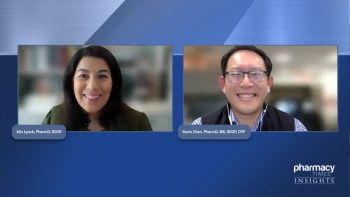
Efficacy and Safety of Topical Agents for Atopic Dermatitis
Kristen Demundo, PharmD, addresses the safety and efficacy of some topical agents used as therapy options for atopic dermatitis.
Episodes in this series

Peter Lio, MD: I’d like to talk about some of the safety and efficacy profile of one of the common things that we use, topical calcineurin inhibitors. These are nonsteroidal agents. They’re pretty exciting. They’ve been with us since around the year 2000, and then we have a newer entry into the nonsteroidal group, our topical phosphodiesterase-4 inhibitor, crisaborole. I’d like us to think about these in terms of how they work, their safety and efficacy. Kristen, can you start us off with a little discussion of these?
Kristen Demundo, PharmD: Absolutely. I’m going to start off with the safety and efficacy profiles of the calcineurin inhibitors. There are 2 topicals that are commonly used, tacrolimus and pimecrolimus. The brand names are Protopic and Elidel. They’ve been around, as you said doctor, for many years. There’s a favorable clinical efficacy proven in these calcineurin inhibitors as shown in multiple clinical trials. Furthermore, studies have shown in children and adults with atopic dermatitis, long-term maintenance therapy with these agents reduced the chance of relapse episodes, which is great because they work more for maintenance as well. Regarding their safety, they exhibit a favorable safety profile without evidence of severe adverse effects. Common adverse effects are really limited to application site reactions, such as burning, erythema, and pruritis with these agents.
A newer medication is crisaborole, and that has the trade name Eucrisa. This is a bit newer in the field, but it’s been very popular, especially among children, because it is not a steroid, and it doesn’t have all the common adverse effects that a lot of parents want to avoid with children. Especially if you’re applying this all over your body, they want something that is safe and doesn’t carry those risks. Regarding the effectiveness, it improves lesion clearing and pruritis in patients with atopic dermatitis to a greater extent than emollient treatments alone. In many studies, significantly more patients treated with Eucrisa achieved results of clear or almost clear as evaluated by investigators compared with using only emollient treatments.
These results reflected a 2-point improvement in lesion clearing on a 5-point assessment scale, which is clinically meaningful. The pruritis and symptoms were responding in a few days, which is great because especially with children, you don’t want to be waiting a very long time to achieve improvement and comfort. More patients will also experience further clearing after a week of treatment.
Regarding common adverse effects, these are also application site related, such as burning, stinging, and worsening of dermatitis. I’ve learned that with these application site reactions, they generally decrease as you continue treatment. That’s an important counseling point for patients, to continue with it, if you can get past the first 3 applications, stick with it because it will improve and those will subside, which is important to note. Hypersensitivity reactions, such as urticaria, rarely occur. There are no available data on the safety of crisaborole in women who are pregnant, breast feeding, or in children younger than 2 or adults over 65 at this point.
Peter Lio, MD: That’s a great overview of our nonsteroidal agents because the typical first-line treatment for atopic dermatitis is going to be our topical steroids. They meet those 5 criteria pretty well. They’re very effective, they work quickly, they’re accessible because they’re very inexpensive, and they have good safety when they’re used correctly, of course, and really high tolerability. But as you said, sometimes they’re not going to be useful in the medium and long term if people are overusing them, and they could actually have greater risks than their benefits would allow. That’s where these nonsteroidal agents particularly help.
The biggest problem that we find with the nonsteroidal agents is 1) they’re pretty expensive compared to corticosteroids, that can be an issue. And number 2) as you really nicely discussed, the stinging and burning, which it does seem like most patients can get through or push past. For some, unfortunately, it can be a deal breaker. Crisaborole is exciting because it got its new indication at a lower age group just last year. So now it’s actually FDA approved down to 3 months of age, which is unique among those. That changes the game and makes it a little bit more favorable, because there’s so little, as you said, available for kids under the age of 2.
The last part about this whole discussion is the concept of a maintenance approach. We usually could use a topical steroid to get things better quickly, but these can be wonderful agents to help maintain atopic dermatitis in the medium to long term. That’s exactly what you talked about, how they were studied. In particular, Andreas Wollenberg, [MD] from Munich, Germany, has done some beautiful work talking about a proactive approach, using them kind of more regularly to keep things down and prevent flare-ups over time. That was really excellent, thank you for that.
This transcript has been edited for clarity.
Newsletter
Stay informed on drug updates, treatment guidelines, and pharmacy practice trends—subscribe to Pharmacy Times for weekly clinical insights.












































































































































































































